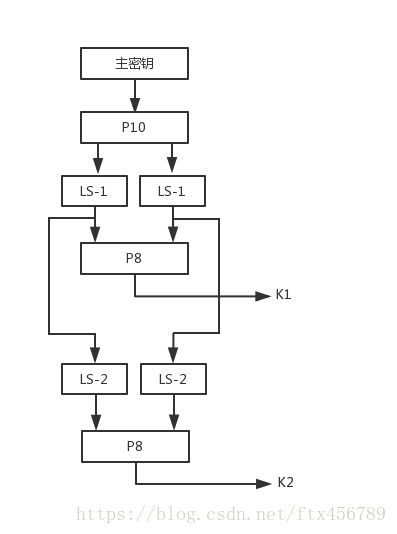S-DES加密算法介绍与实现
为了更好地理解DES算法,美国圣克拉拉大学的Edward Schaefer教授于1996年开发了Simplfied DES方案,简称S-DES方案。它是一个供教学而非安全使用的加密算法,它与DES的特性和结构类似,但参数小,明文分组为8位,主密钥分组为10位,采用两轮选代。

S-DES的加密原理图如上图所示
S-DES的具体实现步骤:
- 初始置换IP:将8位的明文按照置换顺序分为左4位 L0 L 0 和右4位 R0 R 0
- 第1轮运算, R0 R 0 一方面直接输出作为下一轮的 L1 L 1 ,另一方面作为f函数的输入与8位的子密钥 K1 K 1 参与函数运算,运算结果与 L0 L 0 异或,结果作为下一轮的 R1 R 1
- 第2轮运算, R1 R 1 一方面直接输出作为下一轮的 R2 R 2 ,另一方面作为f函数的输入与8位子密钥 K2 K 2 参与函数运算,运算结构与 L1 L 1 异或,结果作为下一轮的 L2 L 2
- 逆置换 IP−1 I P − 1
- 主密钥K进行P10置换(35274,10,1986)
- 分成左5位和右5位,再进行 LS−1 L S − 1 操作(左循环1位),其结果一方面作为下一轮的初始值,一方面进行P8置换(637485,10,9),得到 K1 K 1
- 将上一轮结果分布左循环2位,经过P8置换,得到 K2 K 2

S-DES的f函数结构如上图所示
S-DES的f函数结构的具体实现步骤:
- E/P扩展及置换: 将4位扩展为8位
- 扩展后的8位与密钥 K1 K 1 或 K2 K 2 异或,输出8位
- 左边4位作为 S1 S 1 ,输入,右边4位作为 S2 S 2 输入
- 在 S1 S 1 和 S2 S 2 中,分别将第1位与第4位结合,形成2位代表S盒的行号,分别将第2位与第3位结合,形成2位代表S盒的列号,从而得到S盒的输出。S-DES的S盒如下表所示
- 进行 P4 P 4 置换,得到 f f 函数的输出
S-DES的S盒
| S1 S 1 | 00 00 | 01 01 | 10 10 | 11 11 | S2 S 2 | 00 00 | 01 01 | 10 10 | 11 11 |
| 00 00 | 01 | 00 | 11 | 10 | 00 00 | 00 | 01 | 10 | 11 |
| 01 01 | 11 | 10 | 01 | 00 | 01 01 | 10 | 00 | 01 | 11 |
| 10 10 | 00 | 10 | 01 | 11 | 10 10 | 11 | 10 | 01 | 00 |
| 11 11 | 11 | 01 | 00 | 10 | 11 11 | 10 | 01 | 00 | 11 |
S-DES解密的步骤:
- IP置换(26314857)
- 如图一逆过程从 L2 L 2 和 R2 R 2 开始倒着来
- IP−1 I P − 1 置换(41357286)
如设主密钥 K K =1010000010,用S-DES加密明文字母 C C
- 先求得 K1 K 1 和 K2 K 2 ,主密钥经过P10置换的到:1000001100
- LS−1 L S − 1 操作:0000111000
- P8置换产生 K1 K 1 :10100100
- LS−2 L S − 2 操作:0010000011
- P8置换产生 K2 K 2 :01000011
- 字母 C C 的ASCII码为67,对应二进制位01000011
- IP置换: L0 L 0 =1000, R0 R 0 =0101
- 第1轮: f(R0,K1) f ( R 0 , K 1 ) =1000, L0⨁f=1000⨁1000=0000 L 0 ⨁ f = 1000 ⨁ 1000 = 0000
- L1=R0=0101 L 1 = R 0 = 0101 , R1 R 1 =0000
- 第二轮: f(R1,K2) f ( R 1 , K 2 ) =1001, L1⨁f=0101⨁1001=1100 L 1 ⨁ f = 0101 ⨁ 1001 = 1100
- L2 L 2 =1100, R2=R1=0000 R 2 = R 1 = 0000
- IP−1 I P − 1 置换:01000100(ASCII码为68,对应字母D)
所以我们可以将其程序化
#include 